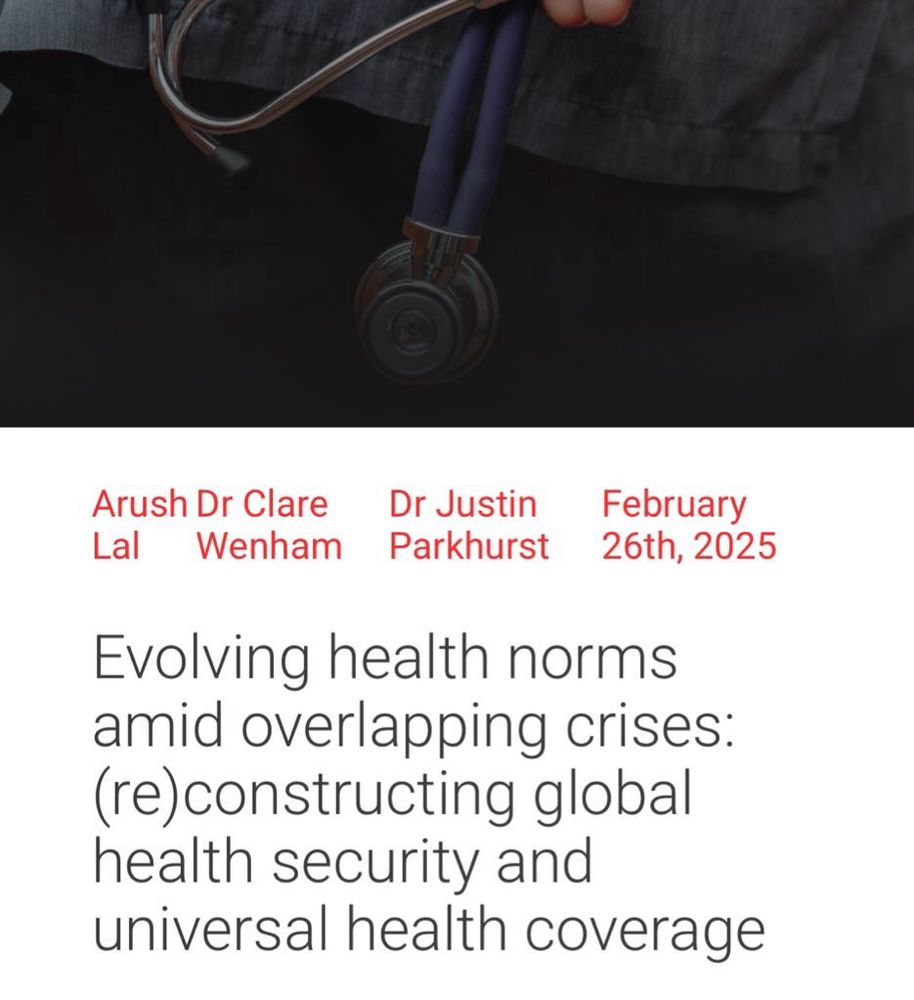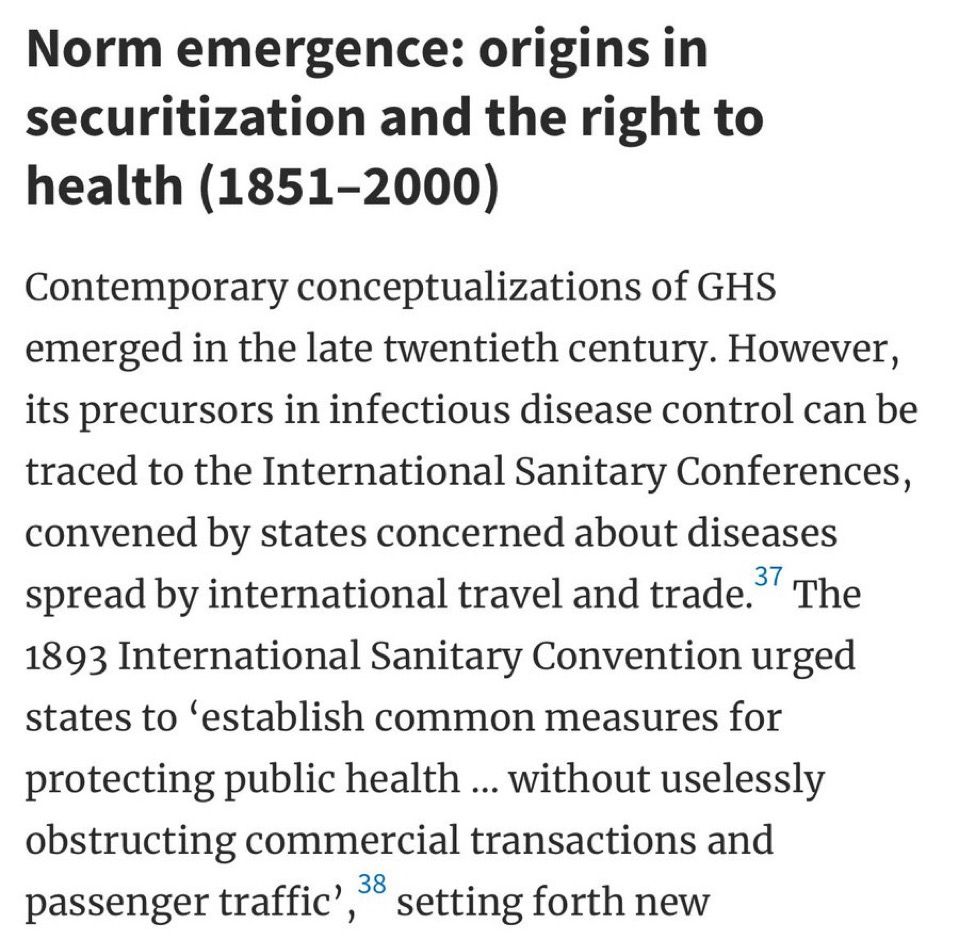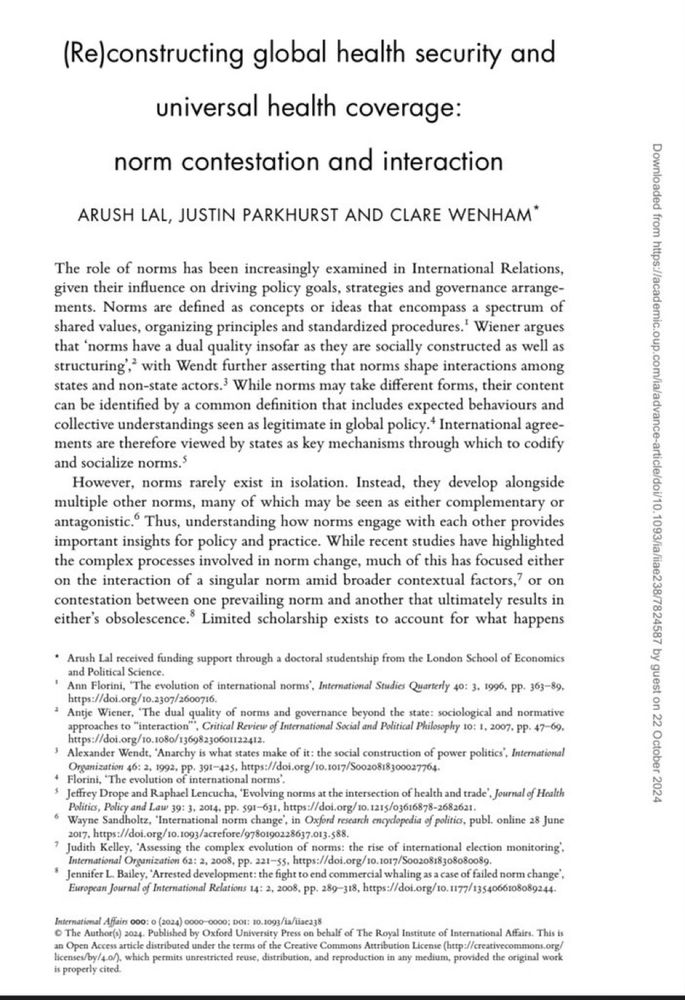
📑 PhD - LSE Health Policy
Researching diplomacy, health security, and UHC. Advocating for health equity and resilience.
Views my own.
https://www.lse.ac.uk/health-policy/people/PhDs/Arush-Lal
📘 Full thesis: etheses.lse.ac.uk/4906/




📘 Full thesis: etheses.lse.ac.uk/4906/
Title: "Hybrid norms and the politics of integration: evolving linkages between global health security and universal health coverage" ⬇️


Title: "Hybrid norms and the politics of integration: evolving linkages between global health security and universal health coverage" ⬇️
I’ll be leading strategy and engagement on pandemic prevention and preparedness — connecting diplomacy to public health and helping shape a more equitable and resilient health security architecture.
@theelders.bsky.social

I’ll be leading strategy and engagement on pandemic prevention and preparedness — connecting diplomacy to public health and helping shape a more equitable and resilient health security architecture.
@theelders.bsky.social
📌 Greater understanding of how normative convergence can bridge distinct goals for future global governance
📌 Importance of cross-cutting frames, ‘hybrid norms’, and strategic convergence to secure wins in contested negotiations via diplomacy
🔗 doi.org/10.1186/s129...

📌 Greater understanding of how normative convergence can bridge distinct goals for future global governance
📌 Importance of cross-cutting frames, ‘hybrid norms’, and strategic convergence to secure wins in contested negotiations via diplomacy
🔗 doi.org/10.1186/s129...
📌 Convergence isn’t necessarily obvious—it often happens through incremental linkages in discourse & core functions
📌 Diplomatic efforts must navigate complex geopolitics & entrenched path dependencies to drive lasting integration
🔗 doi.org/10.1186/s129...

📌 Convergence isn’t necessarily obvious—it often happens through incremental linkages in discourse & core functions
📌 Diplomatic efforts must navigate complex geopolitics & entrenched path dependencies to drive lasting integration
🔗 doi.org/10.1186/s129...
Negotiations forced compromises:
⏺️Insertion of caveats & qualifiers
⏺️Substituting direct ‘contentious’ language w/ ‘palatable proxies’
⏺️Forum-shifting to other venues
🔗 doi.org/10.1186/s129...

Negotiations forced compromises:
⏺️Insertion of caveats & qualifiers
⏺️Substituting direct ‘contentious’ language w/ ‘palatable proxies’
⏺️Forum-shifting to other venues
🔗 doi.org/10.1186/s129...
Growing complementarity signals:
⏺️ Convergence isn’t always explicit—can be implicit
⏺️ GHS & UHC are increasingly viewed as reinforcing (rather than competing) w/ each other
🔗 doi.org/10.1186/s129...

Growing complementarity signals:
⏺️ Convergence isn’t always explicit—can be implicit
⏺️ GHS & UHC are increasingly viewed as reinforcing (rather than competing) w/ each other
🔗 doi.org/10.1186/s129...
The crisis pushed policymakers to:
⏺️ Recognize overlapping priorities to build consensus
⏺️ Use ‘equity’ & ‘resilience’ as key frames for future global health
🔗 doi.org/10.1186/s129...

The crisis pushed policymakers to:
⏺️ Recognize overlapping priorities to build consensus
⏺️ Use ‘equity’ & ‘resilience’ as key frames for future global health
🔗 doi.org/10.1186/s129...
📌 How UHC was promoted in the WHO Pandemic Agreement
📌 How GHS was promoted in the 2023 UNGA Political Declaration on UHC
💡Broader implications for health diplomacy, governance, & norm integration
🔗: doi.org/10.1186/s129...

📌 How UHC was promoted in the WHO Pandemic Agreement
📌 How GHS was promoted in the 2023 UNGA Political Declaration on UHC
💡Broader implications for health diplomacy, governance, & norm integration
🔗: doi.org/10.1186/s129...
And how is the relationship between GHS & UHC be shifting in since the pandemic?
Spoiler alert: they’re converging—but not without friction.
@lsehealthpolicy.bsky.social
🔗: doi.org/10.1186/s129...

And how is the relationship between GHS & UHC be shifting in since the pandemic?
Spoiler alert: they’re converging—but not without friction.
@lsehealthpolicy.bsky.social
🔗: doi.org/10.1186/s129...
Both are critical to strong health systems—yet siloed efforts undermine public health.
@lseglobalhealth.bsky.social
🔗: doi.org/10.1186/s129...

Both are critical to strong health systems—yet siloed efforts undermine public health.
@lseglobalhealth.bsky.social
🔗: doi.org/10.1186/s129...
How do we balance pandemic preparedness with health systems that actually improve access to care?
Our latest in @biomedcentral.bsky.social Globalization & Health dives into this urgent question.
🔗: doi.org/10.1186/s129...
🧵⬇️

How do we balance pandemic preparedness with health systems that actually improve access to care?
Our latest in @biomedcentral.bsky.social Globalization & Health dives into this urgent question.
🔗: doi.org/10.1186/s129...
🧵⬇️
If countries keep separating emergency preparedness from routine care, we’ll keep seeing the same failures.
Our research makes the case for joint (dual-purpose) investments, integrated policies, and new ways of thinking about global health.

If countries keep separating emergency preparedness from routine care, we’ll keep seeing the same failures.
Our research makes the case for joint (dual-purpose) investments, integrated policies, and new ways of thinking about global health.
Rising nationalism and eroding multilateralism threaten progress.
How do we build health systems that are BOTH crisis-ready & universally accessible?
Our latest op-ed: blogs.lse.ac.uk/globalhealth...

Rising nationalism and eroding multilateralism threaten progress.
How do we build health systems that are BOTH crisis-ready & universally accessible?
Our latest op-ed: blogs.lse.ac.uk/globalhealth...
If countries keep separating emergency preparedness from routine care, we’ll keep seeing the same failures.
Our research makes the case for joint (dual-purpose) investments, integrated policies, and new ways of thinking about global health.

If countries keep separating emergency preparedness from routine care, we’ll keep seeing the same failures.
Our research makes the case for joint (dual-purpose) investments, integrated policies, and new ways of thinking about global health.
✅ Understanding how norms interact, evolve, and reinforce each other offers new pathways for diplomacy in health, climate, security, and beyond.
❌ Further research needed on norm convergence and coherence.
🔗: doi.org/10.1093/ia/iiae238

✅ Understanding how norms interact, evolve, and reinforce each other offers new pathways for diplomacy in health, climate, security, and beyond.
❌ Further research needed on norm convergence and coherence.
🔗: doi.org/10.1093/ia/iiae238
✅ Understanding the co-evolution of GHS & UHC offers lessons to strategically invest + advance both through overlapping crises.
❌ Challenges remain in reconciling their diverse constituencies & conceptualizations.
🔗: doi.org/10.1093/ia/iiae238

✅ Understanding the co-evolution of GHS & UHC offers lessons to strategically invest + advance both through overlapping crises.
❌ Challenges remain in reconciling their diverse constituencies & conceptualizations.
🔗: doi.org/10.1093/ia/iiae238
Over time, GHS & UHC norms have become increasingly integrated and viewed as ‘mutually-reinforcing’
Leveraging their complementary strengths (eg, equity, resilience) can be useful in pandemic agreement negotiations, post-SDG planning, etc.
🔗: doi.org/10.1093/ia/iiae238

Over time, GHS & UHC norms have become increasingly integrated and viewed as ‘mutually-reinforcing’
Leveraging their complementary strengths (eg, equity, resilience) can be useful in pandemic agreement negotiations, post-SDG planning, etc.
🔗: doi.org/10.1093/ia/iiae238
GHS & UHC norms have significantly shaped each other.
Repeated contestation and interaction has helped both adapt to maintain relevance—with different framings emphasized at different times.
They’re more connected than we think! 🤝
🔗: doi.org/10.1093/ia/iiae238

GHS & UHC norms have significantly shaped each other.
Repeated contestation and interaction has helped both adapt to maintain relevance—with different framings emphasized at different times.
They’re more connected than we think! 🤝
🔗: doi.org/10.1093/ia/iiae238
The content + scope of GHS & UHC norms has continually evolved.
📜 Norms don’t stay ‘fixed’. They shift in response to global events & int’l agreements.
GHS & UHC norms have always been—and will continue to be—in a constant state of flux.
🔗: doi.org/10.1093/ia/iiae238

The content + scope of GHS & UHC norms has continually evolved.
📜 Norms don’t stay ‘fixed’. They shift in response to global events & int’l agreements.
GHS & UHC norms have always been—and will continue to be—in a constant state of flux.
🔗: doi.org/10.1093/ia/iiae238
Health emergencies like Ebola & Zika sped up GHS/UHC convergence.
The SDGs & WHO GPW13 further institutionalized their integration.
2019 UHC Political Declaration + WHO Health Emergencies Reports utilize explicitly interlinked framings.
🔗: doi.org/10.1093/ia/iiae238

Health emergencies like Ebola & Zika sped up GHS/UHC convergence.
The SDGs & WHO GPW13 further institutionalized their integration.
2019 UHC Political Declaration + WHO Health Emergencies Reports utilize explicitly interlinked framings.
🔗: doi.org/10.1093/ia/iiae238
GHS tipping point followed SARS + revised IHR (2005).
UHC tipping point followed 2010 World Health Report + 2012 UNGA Resolution.
🔍 A closer look reveals both were evolving *in response* to each other (eg, blindspots in HIV/AIDS & MDGs)
🔗: doi.org/10.1093/ia/iiae238

GHS tipping point followed SARS + revised IHR (2005).
UHC tipping point followed 2010 World Health Report + 2012 UNGA Resolution.
🔍 A closer look reveals both were evolving *in response* to each other (eg, blindspots in HIV/AIDS & MDGs)
🔗: doi.org/10.1093/ia/iiae238
GHS emerged via infectious disease control & post-Cold War foreign policy.
UHC emerged via UN human rights, Alma-Ata Declaration, etc.
Despite distinct origins in securitization & rights-based frameworks, they were shaped by overlapping actors/contexts.
🔗: doi.org/10.1093/ia/iiae238

GHS emerged via infectious disease control & post-Cold War foreign policy.
UHC emerged via UN human rights, Alma-Ata Declaration, etc.
Despite distinct origins in securitization & rights-based frameworks, they were shaped by overlapping actors/contexts.
🔗: doi.org/10.1093/ia/iiae238
💡GHS & UHC are better understood as ‘processes’—evolving from distinct concepts to synergistic norm regimes.
🔗: doi.org/10.1093/ia/iiae238

💡GHS & UHC are better understood as ‘processes’—evolving from distinct concepts to synergistic norm regimes.
🔗: doi.org/10.1093/ia/iiae238
Fragmentation between GHS & UHC routinely leads to policy incoherence + weakened health systems.
We saw this during #COVID19, Ebola, Zika, etc.
Understanding their shared past can inform effective integration moving forward.
🔗: doi.org/10.1093/ia/iiae238

Fragmentation between GHS & UHC routinely leads to policy incoherence + weakened health systems.
We saw this during #COVID19, Ebola, Zika, etc.
Understanding their shared past can inform effective integration moving forward.
🔗: doi.org/10.1093/ia/iiae238

